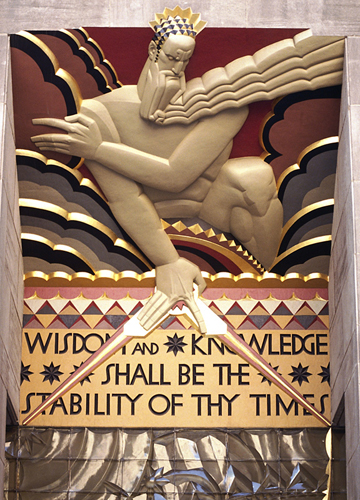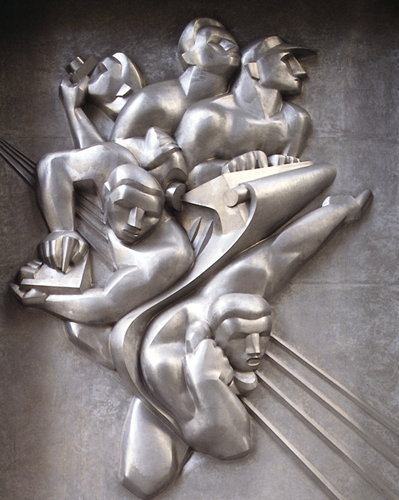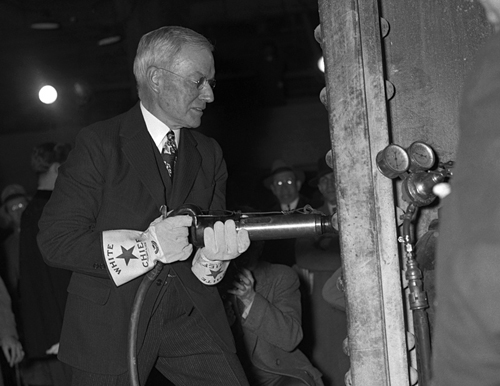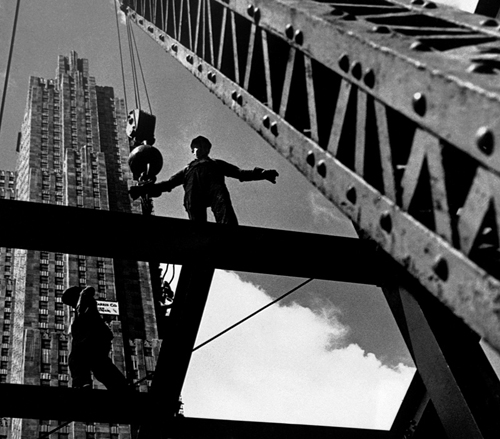Rockefeller Center Artworks
American Progress Jose Maria Sert’s (1876–1945) mural depicts America’s development over 300 years by uniting two forces, brain and brawn. Sert’s Time mural adorns one of the ceilings. Wisdom The striking central figure of Wisdom
by Lee Lawrie (1877– 1963) grasps a compass pointing to light and sound
waves and is carved on a screen made of 240 glass blocks.

Gaston Lachaise’s panels This
two-panel work by the noted American sculptor (1882– 1935) honors the
contribution made by workmen to the Rockefeller Center’s construction,
depicting them at their labors. News This
heroic sculpture by Isamu Noguchi (1904–88) is cast in stainless steel.
The 10-ton panel illustrates the tools of the press, including camera,
telephone, pad, and pencil.

News, Isamu Noguchi
Industries of the British Empire Cast
in bronze and finished in gold leaf, this panel by Carl Paul Jennewein
(1890–1980) depicts nine major industries of the British Commonwealth,
including sugar cane, salt, and tobacco. Intelligence Awakening Mankind Some
one million tesserae (pieces of glass enamel) in more than 250 shades
create Barry Faulkner’s (1881–1966) mosaic representing spoken and
written words. Portals Josef
Albers’ 1961 work of thin, highly polished, milky-white and ivory
Carrara glass creates a surface of receding squares that gives the mural
a sense of depth. Winged Mercury Lee
Lawrie’s stunning 1933 relief of Mercury, the Roman god of trade,
profit and commerce, celebrates the British Empire. The golden classical
figure wears a helmet – a sign of protection.

Lee Lawrie’s Winged Mercury
The Story of Mankind Another
Lawrie is a bold 15-block history accented in gold, scarlet and
blue-green. The history is topped with a clock, signifying the passage
of time. Wall Drawing 896 The
newest mural, a site-specific, geometric design created in 1999 by Sol
Lewitt, covers four walls of the entrance to the headquarters of
Christie’s on 48th St.
The Building of Rockefeller Center
When the Depression made
John D. Rockefeller Jr.’s original plan for a new opera house
impractical, he instead developed a large, creative-commercial complex.
The innovative Art Deco design, led by Raymond Hood, included a
mid-block street (Rockefeller Plaza) and an underground concourse. The
14 buildings constructed in 1931–40 provided 225,000 jobs during the
worst of the Depression. Artworks were an essential element; over 30
artists contributed work for foyers, façades, and gardens as part of the
“New Frontiers” program.

John D. Rockefeller driving in final rivet

Rockefeller Center construction workers, 1932
Top 10 StatisticsTallest building: 850 ft (259 m), 70 floors Passenger rides per day: more than 400,000 Fastest elevator speed: 1,400 ft (427 m) per minute (37 seconds non-stop to 65th floor) Number working in the complex: 65,000
|